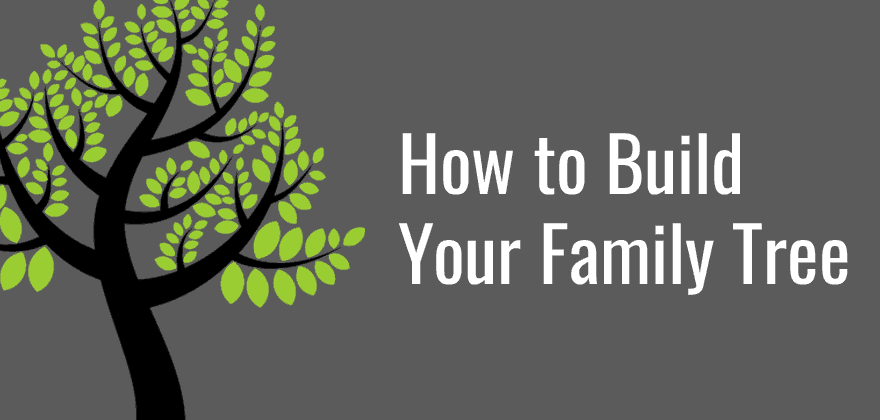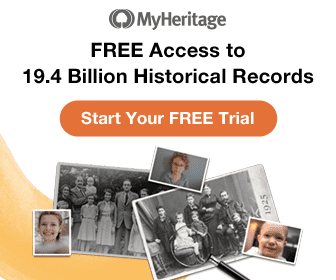If you have any interest at all in genealogy or family history, at some point you’re going to want to start recording your family tree. Here are some suggestions for starting off right.
Decide How To Record It
Are you going to record your information with pen and paper or on a computer? Both have their advantages.
Paper
People have been recording their genealogy on paper for hundreds of years, and it’s still a perfectly acceptable way to go.
There are many charts available online that you can print off and fill in by hand. Be sure to find a form that lets you fill in as many major life events as possible: birth, marriage, and death dates and locations at a minimum.
Keeping your records on paper is the only way to go if you don’t own a computer, and it lets you take your records along on research trips if you don’t have a laptop.
There’s also no chance of losing your information due to computer failure. However, there are still ways your paper records can be lost or damaged, so you should make photocopies of them from time to time as backups.
Computer
There are dozens of computer programs that let you build your family tree electronically. I personally use RootsMagic.
Most programs come with a tutorial to get you started entering your information.
Keeping your records on your computer makes it easier to fix mistakes (no eraser or whiteout required), sort your ancestors in different ways, and enter additional life events such as baptisms, graduations, moving to a new city, and more.
Every genealogy software package also lets you print off your information on a variety of forms and charts.
But be sure to back up your data every time you use it. Use an automatic online backup if possible.
Recording Your Information
Whether you are keeping records on paper or online, most of your information is going to be recorded on two basic chart forms, ancestral charts and family group sheets.
Ancestral Charts
The ancestral chart is what most of us think of when we picture family trees. It starts with one person and works backward through time, generation by generation.
Most ancestral charts are four-generation or five-generation. A four-generation chart starts with a person and works back to her great-grandparents.
A five-generation chart includes great-great-grandparents as well.
Once again, look for charts that let you fill in as many life events as possible. It is more important to have extra information about the people on the chart than it is to have extra generations on the chart. You can always add more pages to fill in generations.
Family Group Sheets
A family group sheet brings together just two generations, parents and their children.
Family group sheets give you more room to fill in certain events. They are also the only place you will record many of the people you find while tracing your family tree.
Consider your siblings. Your parents are listed on your ancestral chart, but your siblings aren’t. That makes sense: they aren’t your ancestors.
Family group sheets let you capture information about your siblings (or your father’s siblings, or your great-grandmother’s) that doesn’t fit on other forms.
Start With What You Know
The best place to start your family tree is with yourself.
That means an ancestral chart that begins with you, and a family group sheet with you as a child (you can do a family group sheet with you as a parent second).
Fill in your information: your birth name, date and place of birth, and date and place of marriage if appropriate. Then fill in your parents’ names and other details.
On the family group sheet, list all of your siblings and their information.
An important note on names: always use the person’s birth name. This especially means using the maiden name for married women, but names change through adoption or for other reasons as well.
The only way to ensure consistency is to always use the birth name. Many genealogists prefer to write surnames in all capital letters. Nicknames can be included in quotes (Margaret Susan “Peggy Sue” SMITH).
Once you have yourself and your parents listed, you can start working your way back. Fill in your grandparents’ names if you know them, and any dates you already know.
Don’t worry about how much you have to leave blank at first. That’s what your family history search is all about, filling in the blanks.
Document Your Sources
Get into the habit right away of only including information in your family chart that you can prove.
If you’re not 100% sure of your mom’s date of birth, leave it blank until you can be sure. And for every piece of data you add to your tree, find something that proves it.
I recommend keeping your research notes separate from your family tree, only adding to your tree once you’ve actually proven the fact.
There are far too many pieces of information to get into here, but some of the most common ones include: birth, marriage, and death certificates; census records; and court records.
Don’t overlook oral sources of information, but try to back them up with other sources when you get a chance.
So if your mom tells you she was born on June 30, 1949, chances are that she’s right and you can fill that in. Although technically that information is considered secondary information – more on that in future articles.
If you can find a copy of her original birth certificate to confirm it, that’s better.
Note that when I say original, I mean original. I don’t mean an online index or any other type of derivative sources.
Keep copies of your source documents in a folder: either paper documents in a physical file folder or scanned documents in a computer folder.
Either way, keeping good records now, at the beginning of your search, is going to save you a lot of work later.
Start Now
The most important part of tracing your genealogy is starting right away. Records get lost, memories fade, family members pass away. You need to start recording that information now, right away, so you can preserve it for your family for generations to come.




Concerning sharing segments of DNA: If one has a DNA match of 1 or 2 segments are they a distant relative? Is it possible to share a tiny segment and not be related?
Does even a tiny match mean a distant past common ancestor?
Yes, tiny matches on 1 or 2 segments can just be noise and can mean there’s no relation. Depends on the length of the matching segments.